

The brake fluid has a very low compression coefficient so that almost all the movement of the brake lever or pedal is transmitted directly to the caliper for braking action. Air, however, is easily compressed. When air enters the brake lines, brake lever or pedal movement will be partially used in compressing the air. This will make the lever or pedal feel spongy, and there will be a loss in braking power.
| WARNING Air in the brake lines diminish braking performance and can cause an accident resulting in injury or death. If the brake lever or pedal has a soft or "spongy" feeling mushy when it is applied, there might be air in the brake lines or the brake may be defective. Do not operate the vehicle and service the brake system immediately. |
NOTE
The procedure to bleed the front brake line is as follows.
Bleeding the rear brake line is the same as for the front brake.
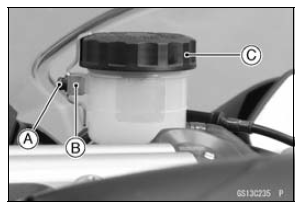
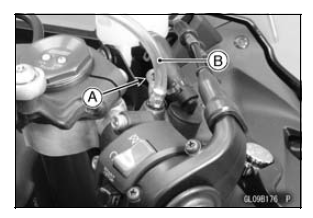
Repeat this operation until no more air can be seen coming out into the plastic hose.
1. Pump the brake lever until it becomes hard, and apply the brake and hold it [A].
2. Quickly open and close [B] the bleed valve while holding the brake applied.
3. Release the brake [C].
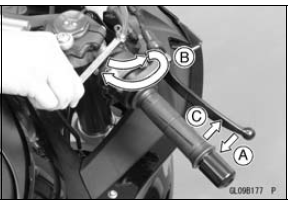
NOTE
The fluid level must be checked often during the bleeding operation and replenished with fresh brake fluid as necessary. If the fluid in the reservoir runs completely out any time during bleeding, the bleeding operation must be done over again from the beginning since air will have entered the line.
Torque - Front Master Cylinder Bleed Valve: 5.4 N·m (0.55 kgf·m, 48 in·lb)
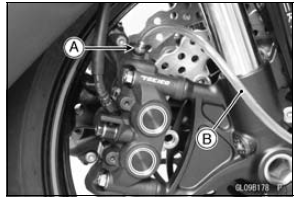
Repeat this operation until no more air can be seen coming out into the plastic hose.
1. Pump the brake lever until it becomes hard, and apply the brake and hold it [A].
2. Quickly open and close [B] the bleed valve while holding the brake applied.
3. Release the brake [C].
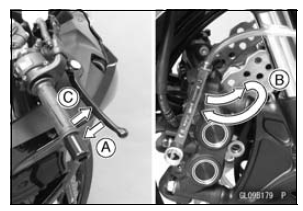
NOTE
First, tighten the brake fluid reservoir cap [B] clockwise [C] by hand until slight resistance is felt indicating that the cap is seated on the reservoir body, then tighten the cap an additional 1/6 turn [D] while holding the brake fluid reservoir body [A].
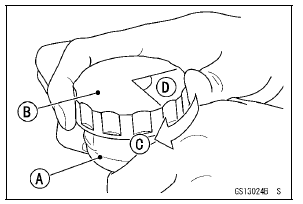
Torque - Bleed Valves: 7.8 N·m (0.80 kgf·m, 69 in·lb)
| WARNING When working with the disc brake, observe the precautions listed below.
|
 Brake Fluid Level Inspection
Brake Fluid Level Inspection Brake Hose
Brake HoseFuel Tank Removal
WARNINGGasoline is extremely flammable and can be
explosive
under certain conditions, creating the
potential for serious burns. Make sure the area is
well-ventilated and free from any source of flame
or sparks; this includes any appliance with a pilot
light. Do not smoke. T ...
Tire Air Pressure Inspection
Remove the air valve cap.
Measure the tire air pressure with an air pressure gauge
[A] when the tires are cold (that is, when the motorcycle
has not been ridden more than a mile during the past 3
hours).
Install the air valve cap.
Adjust the tire air pressure according to the specifi ...
Fluid Level Inspection
With the brake fluid reservoirs held
horizontal, the brake fluid level must
be kept between the upper and lower
level lines.
A. Front Brake Fluid Reservoir
B. Upper Level Line
C. Lower Level Line
A. Rear Brake Fluid Reservoir
B. Upper Level Line
C. Lower Level Line
If th ...